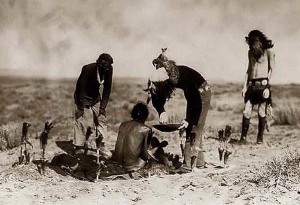The federal government has long provided for inspection in most areas over which it has control, and Indian reservations were no exception. In 1904, the legislature published Laws and Treaties, Vol. I, which outlined laws, policies, and procedures pertaining to its “Indian Affairs” responsibilities. Continue reading
Category Archives: Indian tribes
New Reasons for Insanity
Many (white) observers over the years believed that insanity was rare among Native Americans. Their conclusion was born out during the Indian Bureau survey that tried to assess the need for a special asylum for insane Indians; among the thousands and thousands of Indians living on reservations, fewer than a hundred could be identified with mental problems. Continue reading
Another Sad Twist
The argument can certainly be made that very few patients at the Canton Asylum for Insane Indians were what might be called “classically insane,” with complete disassociation from reality, a complete change in personality, or a complete inability to function within their traditional society. Continue reading
Food Scarcity

Cheyenne-Arapaho Ration Card Used During the Time of the Land Run, courtesy Oklahoma Historical Society
Winter had always been a time of scarcity for both agricultural and nomadic peoples. Even when crops were good and supplies safe, winter generally meant fewer food choices and dwindling stores of edibles that could not be replenished until spring arrived.
Native Americans faced extreme threats to their food supply by the twentieth century: Continue reading
Winter As a Time of Reflection
In most earlier cultures, life slowed during the winter months; people could not plant seed in frozen ground, days were short and dark, and most agricultural tasks were complete. As in today’s practice of contemplation at the New Year, native peoples used winter as a time to reflect on the important events of the previous year. Continue reading
Searching for Canton Asylum Patients
This is an out-of-schedule post to ask for information about Canton Asylum patients transferred to St. Elizabeths in 1933, for a projected memorial. If you have any information about them, particularly about their lives before they were in Canton Asylum, we would both appreciate it. If you’d like to provide any details, you may simply reply to this post or send information to a private email at: deet84803@mypacks.net.
Joanna, Augusta
Bear, Frank
Charlie (only name)
Charley or Charles, Creeping
Dauphinais, Madeline
Ensign, Meda
Fairbanks, Richard
Jackson, Robert
Kalonuheskie, Edith
Rising Fire, Bessie
Shortwoman, Sarah
Tsinnjinnie, Mabel
Vigil, Fidel
Yazza, Zonna or Sonna
Yazzie, Hoskee
Thank you.
Preserving Food

William We-ah-lup Smoking Salmon, 1906, Tulalip Indian Reservation, courtesy University of Washington Libraries
Patients at the Canton Asylum for Insane Indians, though forced to eat a relatively poor diet of increasingly refined foods provided by the government, benefited from the fresh food and meat raised on the asylum grounds. However, there never seemed to be a sufficiency that allowed the kitchen staff to do much in the way of preserving this more nutritious food for winter use. Continue reading
Food Woes
Choices concerning Bran Flakes and Shredded Krumbles (see last post) weren’t the only food problems patients at the Canton Asylum for Insane Indians suffered. They, like most Native Americans, had already lost a basic underpinning of life–their traditional foods. This loss led to nutritional deficiencies and diseases that had never affected them before encountering the white man’s culture. Continue reading
And More Cereal
Cold, flaked cereals were not a part of traditional Native American diets, but many Native Americans on reservations doubtlessly ate them. So did the patients at the Canton Asylum for Insane Indians.
Both Sylvester Graham and John Harvey Kellogg (see last post) considered grains part of a healthy diet, and created products that reflected their beliefs. Whether or not Superintendent Harry Hummer also believed this or simply had to take what was issued to him through the Indian Office, he did serve this breakfast food at the asylum. Continue reading
Native American Ghosts
Native Americans believed in ghosts–spirits who were not at peace. This could happen because someone who died had not been at peace, personally. Unrest could also occur because a person was not buried properly or respectfully. Continue reading






